#basilosaurid
Text

Please welcome Perucetus, the new - and largest- known archeoceti.
A whale of enormous proportions. While it's exact size and weight is certainly a matter of heated debates it was no doubt a really big boi. Here a quick sketch of it approaching a time traveler.
10K notes
·
View notes
Text



hello basilosaurid nation i have been thinking about the perucetus colossus and his tiny little legs !
[id: three drawings of a whale-like animal. they are roughly seal-shaped in terms of body, with a round flat tail and a small protruding oval head. all three have small back legs and feet. the first, coloured purplish, has flipper-like anterior appendages. the second, coloured blue, has big hands at the end of long, wide arms. the third is greenish, and has traditional finger-less whale fins. end id]
159 notes
·
View notes
Text
A heavyweight early whale pushes the boundaries of vertebrate morphology
Published 2nd August 2023
Discovery of a new basilosaurid whale, Perucetus colossus, estimated to have the highest degree of bone mass increase known to date - implies Possibly the heaviest animal ever discovered; Perucetus colossus is known from partial postcranial remains of the middle Eocene epoch in Peru.

Skeletal reconstruction and size compared to human

Artist reconstruction of Perucetus colossus, by A. Gennari
Source:
https://doi.org/10.1038/s41586-023-06381-1
133 notes
·
View notes
Text



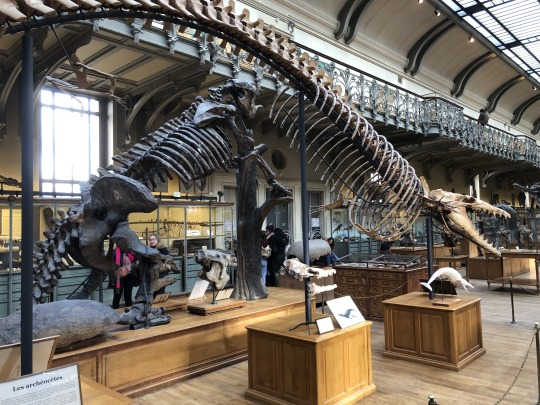
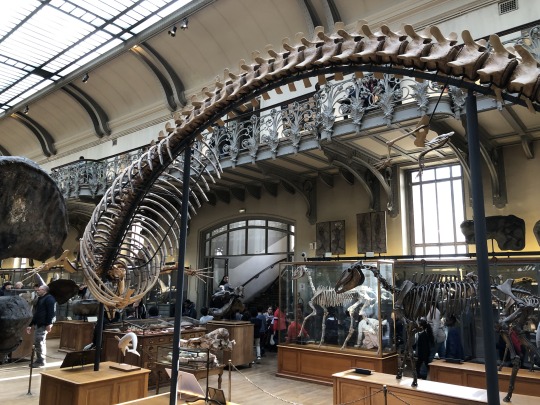
Cynthiacetus. Humans are probably lucky we didn't go to sea until whales that eat large prey were mostly a thing of the past. Then again, orcas don't seem to view us as prey despite hunting plenty of animals our size, so maybe the early whales wouldn't have cared for a bite of human either.
63 notes
·
View notes
Text
Peruvian fossil challenges blue whales for size
3 August 2023

By Jonathan Amos, Science correspondent
Scientists have identified a new candidate for the heaviest ever animal on Planet Earth.
It's an ancient, long-extinct whale that would have tipped the scales at close to 200 tonnes.
Only some of the very biggest blue whale specimens might have rivalled its heft, researchers say.
The creature's fossilised bones were dug up in the desert in southern Peru, so it has been given the name Perucetus colossus.
Dating of the sediments around the remains suggests it lived about 39 million years ago.
"The fossils were actually discovered 13 years ago, but their size and shape meant it took three years just to get them to Lima (the capital of Peru), where they've been studied ever since," said Dr Eli Amson, a co-worker on the discovery team led by palaeontologist Dr Mario Urbina.

Eighteen bones were recovered from the marine mammal - an early type of whale known as a basilosaurid.
These included 13 vertebrae, four ribs and part of a hip bone.
But even given these fragmentary elements and their age, scientists were still able to decipher a huge amount about the creature.
In particular, it's evident the bones were extremely dense, caused by a process known as osteosclerosis in which inner cavities are filled.
The bones were also oversized, in the sense they had extra growth on their exterior surfaces - something called pachyostosis.
These weren't features of disease, the team said, but rather adaptations that would have given this large whale the necessary buoyancy control when foraging in shallow waters.
Similar bone features are seen for example in modern-day manatees, or sea cows, which also inhabit coastal zones in certain parts of the world.
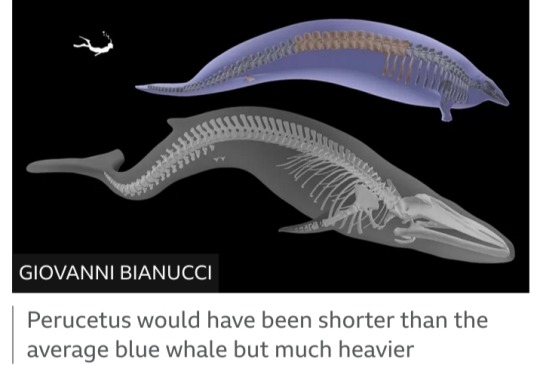
"Each vertebra weighs over 100kg, which is just completely mind-blowing," said co-worker Dr Rebecca Bennion from the Royal Belgian Institute of Natural Sciences in Brussels.
"It took several men to shift them out into the middle of the floor in the museum for me to do some 3D scanning.
The team that drilled into the centre of some of these vertebrae to work out the bone density - the bone was so dense, it broke the drill on the first attempt."
When confronted with a skeleton of a long-extinct species, scientists use models to try to reconstruct the body shape and mass of the animal.
They do this based on what they know about the biology of comparable living creatures.
It is predicted Perucetus would have been about 17-20m in length, which is not exceptional.
But its bone mass alone would have been somewhere between 5.3 and 7.6 tonnes.
And by the time you add in organs, muscle and blubber, it could have weighed - depending on the assumptions - anywhere between 85 tonnes and 320 tonnes.

Dr Amson, a curator at Germany's State Museum of Natural History Stuttgart, uses a median number of 180.
The largest blue whales recorded during the era of commercial exploitation were at this scale.
"What we like to say is that Perucetus is in the same ball park as the blue whale," he told BBC News.
"But there's no reason to think that our individual was particularly big or small; it was likely just part of the general population.
So it's worth keeping in mind that when we use the median estimate, it's already at the very upper ranges of what blue whales can measure."

One of the comparators used by the research team in its investigations is a blue whale that will be very familiar to anyone who has visited the Natural History Museum in London.
Nicknamed Hope, this animal's skeleton took pride of place at the institution when it was hung from the ceiling in the main hall in 2017.
But before being installed, the skeleton was scanned and described in great detail and is now an important data resource for scientists across the world.
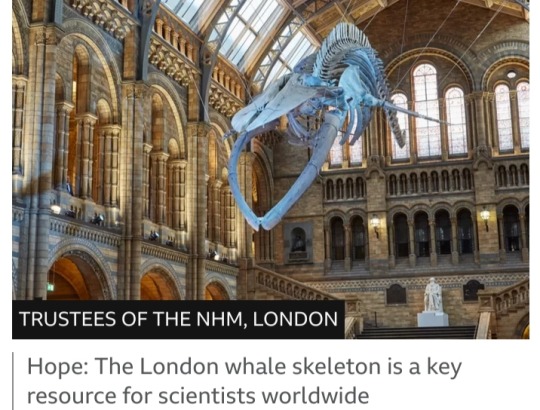
In life, Perucetus' skeletal mass would have been two to three times that of Hope, even though the London mammal was a good five metres longer.
Richard Sabin, the curator of marine mammals at the NHM, is thrilled by the new find and would love to bring some aspect of it to London for display.
"We took the time to digitise Hope - to measure not just the weight of the bones but their shape as well, and our whale has now become something of a touchstone for people," he said.
"We don't get hung up on labels - like 'which was the largest specimen?' - because we know science at some point will always come along with new data.
What's amazing about Perucetus is that it demonstrated so much mass some 30 million-plus years ago when we thought gigantism occurred in whales only 4.5 million years ago."
Perucetus colossus is reported in the journal Nature.
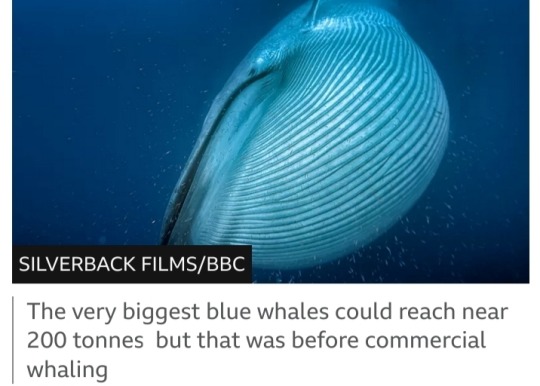
#Perucetus colossus#Perucetus#Peru#fossils#palaeontology#whale#basilosaurid#osteosclerosis#pachyostosis#Royal Belgian Institute of Natural Sciences#long-extinct species#State Museum of Natural History Stuttgart#blue whale#Natural History Museum#Hope#Peruvian fossil
23 notes
·
View notes
Text
youtube
0 notes
Text


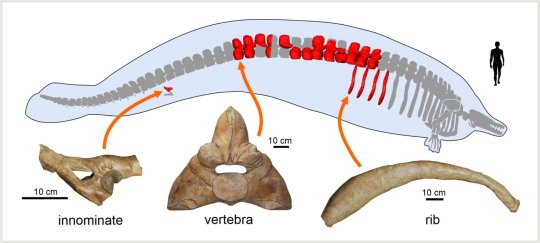
I know I usually talk about crocs, but this is too good not to share. A new giant basilosaurid whale with weird anatomy from the Eocene of Peru.
Perucetus colossus is a peculiar animal. It's bones were incredibly thick and incredibly dense, very much unlike those of modern whales and even more extreme than even those of the thicker basilosaurids (aptly named Pachycetinae i.e. thick whales). These adaptations have been compared to modern manatees and dugongs.
Know the weight range is highly dependent on what you base the math on. Using manatees as a proxy, you get a weight of "only" 85 tons....using extreme values for whales a whopping 340 tons. Mean values for whales a still really big 180 tons. This could indicate that Perucetus rivaled the Blue Whale as the worlds heaviest animal ever.
The ecology is poorly understood tho. We know basilosaurids preferred coastal waters, and with all the similarities to manatees it is reasonable to assume that Perucetus was a shallow water animal itself. It also likely wasn't the fastest swimmer. And the lack of a skull basically means we can't say much on its diet. We can wager a guess and say it wasn't a predator because, you know....it also likely wasn't a grazer. Cool as it would be, we don't really have herbivorous whales like that so its incredibly unlikely. The two more likely suggestions are that it lived on small animals burried in the ocean floor, sorta like a grey whale. Or that it was a scavenger like a sleeper shark (tho I find that suggestion far less likely, giving me scavenging T.rex vibes ngl). But again, once we get a skull we can talk about this better.
Sidenote I do find the name a little underwhelming. It's a bizarre animal and the best we could come up with is "Colossal whale from Peru". I'm also not a mammal person, but from what I'm being told the silhouette is a little exaggerated and it wasn't necessarily that thick in life.
Life reconstruction by A. Gennari, paper can be found here
A heavyweight early whale pushes the boundaries of vertebrate morphology | Nature
#perucetus#basilosauridae#paleontology news#palaeoblr#prehistory#eocene#early whale#evolution#science#whale
2K notes
·
View notes
Text


The archeocete Perucetus colossus dives through a coastal bloom of jellyfish in the Pisco Basin (southern Peru), some time during the Eocene (with bonus multiview).
I originally intended to add epibionts to this reconstruction (reflecting the specialized communities found on many living whales, especially baleen whales). Yet, interestingly, it appears that most animal epibionts and ectoparasites of modern cetaceans, such as whale barnacles (Hayashi et al. 2013) and remoras (Friedman et al. 2013), only appeared in the Neogene or late Paleogene, or have a poorly known (co-)evolutionary history, like whale lice (Pfeiffer 2009, Iwasa-Arai & Serejo 2018) and pennellids (large parasitic copepods) (Hermosilla et al. 2015). So, no epibionts* for big lad Perucetus!
References and notes about the reconstruction:
*animal epibionts. Unicellular eukaryotes like diatoms were most likely present on early cetaceans, given their prevalence on modern large marine animals (Ashworth et al. 2022). Of course, it is possible that other animals (i.e., early, less specialized representatives of modern groups, or different taxa altogether) were also already exploiting the surfaces offered by these early whales; however, this remains entirely speculative.
The reconstruction of Perucetus proposed in its original description (Bianucci et al. 2023) includes some rather odd (if interesting) choices about soft tissues, including limbs with webbed and distinguishable fingers, and a manatee-like tail. While these choices might be defendable in light of the rather basal status of Perucetus among cetaceans, I opted for a more derived look based on the assumption that fully marine cetaceans like basilosaurids would have probably rapidly acquired hydrodynamically favorable adaptations, pushing them towards a more familiar Neoceti-like appearance (even though Perucetus itself was likely a poor swimmer (Bianucci et al. 2023), it seems likely to me that this was a secondarily acquired trait, given the less extreme morphology of other basilosaurids).
Reconstruction in the multiview scaled to ~18 m in length after the estimations of Bianucci et al. (2023).
References:
Ashworth, M. P., Majewska, R., Frankovich, T. A., Sullivan, M., Bosak, S., Filek, K., Van de Vijver, B., Arendt, M., Schwenter, J., Nel, R., Robinson, N. J., Gary, M. P., Theriot, E. C., Stacy, N. I., Lam, D. W., Perrault, J. R., Manire, C. A., & Manning, S. R. (2022). Cultivating epizoic diatoms provides insights into the evolution and ecology of both epibionts and hosts. Scientific Reports, 12(1), Article 1. https://doi.org/10.1038/s41598-022-19064-0
Bianucci, G., Lambert, O., Urbina, M., Merella, M., Collareta, A., Bennion, R., Salas-Gismondi, R., Benites-Palomino, A., Post, K., de Muizon, C., Bosio, G., Di Celma, C., Malinverno, E., Pierantoni, P. P., Villa, I. M., & Amson, E. (2023). A heavyweight early whale pushes the boundaries of vertebrate morphology. Nature, 620(7975), Article 7975. https://doi.org/10.1038/s41586-023-06381-1
Friedman, M., Johanson, Z., Harrington, R. C., Near, T. J., & Graham, M. R. (2013). An early fossil remora (Echeneoidea) reveals the evolutionary assembly of the adhesion disc. Proceedings of the Royal Society B: Biological Sciences, 280(1766), 20131200. https://doi.org/10.1098/rspb.2013.1200
Hayashi, R., Chan, B. K. K., Simon-Blecher, N., Watanabe, H., Guy-Haim, T., Yonezawa, T., Levy, Y., Shuto, T., & Achituv, Y. (2013). Phylogenetic position and evolutionary history of the turtle and whale barnacles (Cirripedia: Balanomorpha: Coronuloidea). Molecular Phylogenetics and Evolution, 67(1), 9–14. https://doi.org/10.1016/j.ympev.2012.12.018
Hermosilla, C., Silva, L. M. R., Prieto, R., Kleinertz, S., Taubert, A., & Silva, M. A. (2015). Endo- and ectoparasites of large whales (Cetartiodactyla: Balaenopteridae, Physeteridae): Overcoming difficulties in obtaining appropriate samples by non- and minimally-invasive methods. International Journal for Parasitology: Parasites and Wildlife, 4(3), 414–420. https://doi.org/10.1016/j.ijppaw.2015.11.002
Pfeiffer, C. J. (2009). Whale Lice. In W. F. Perrin, B. Würsig, & J. G. M. Thewissen (Eds.), Encyclopedia of Marine Mammals (Second Edition) (pp. 1220–1223). Academic Press. https://doi.org/10.1016/B978-0-12-373553-9.00279-0
#'a heavyweight early whale pushes the boundaries of...' blablabla you've all read it by now#i have nothing to add#it's fat#look at it#that is all#perucetus#cetacean#mammal#vertebrate#eocene#cenozoic#paleontology#palaeoblr#paleoart#my art
399 notes
·
View notes
Text

While last week's Tutcetus was the smallest known basilosaurid whale, another recently-announced member of that group was almost the complete opposite.
Perucetus colossus was a chonker. An absolute unit of a whale.
Living during the Eocene (~38 million years ago) in shallow marine waters covering what is now the coast of Peru, this ancient whale is known from several vertebrae, ribs, and parts of its pelvis. As a result its full size is uncertain, but based on the proportions of other basilosaurids it was probably somewhere around 17-20m long (~56'-66') – similar in length to the larger specimens of Basilosaurus.
However, it had much thicker denser bones, even more so than those of its close relative Antaecetus, suggesting that its full body mass was much higher than the rather slender Basilosaurus – and possibly heavier than even modern blue whales despite being shorter in overall length.
Perucetus' thickened vertebrae were also fairly inflexible in most directions, indicating it was a sirenian-like slow swimmer with limited maneuverability – but it did have a surprisingly good ability to bend its body downwards. Without skull material it's unclear what its diet was like, but it may have been a suction-feeder hoovering up seafloor prey like modern grey whales or walruses.
I've reconstructed it here with a speculative bristly fleshy downturned snout inspired by the weird skull of Makaracetus, an earlier whale that may have also been a walrus-like bottom-feeder.
———
NixIllustration.com | Tumblr | Patreon
#science illustration#paleontology#paleoart#palaeoblr#perucetus#pachycetinae#basilosauridae#pelagiceti#archaeoceti#cetacean#whale#artiodactyla#ungulate#mammal#art#speculative reconstruction#i am predicting Weird Snoot Shenanigans for this chonkwhale#gotta have some very specialized feeding ecology going on there
390 notes
·
View notes
Text

A fossilized tooth of an indeterminate basilosaurid, possibly Basilosaurus isis from the Samlat Formation in Dakhla, Morocco. It is unclear if the larger teeth from these ancient whales can be attributed to Basilosaurus.
#synapsid#mammal#fossils#paleontology#palaeontology#paleo#palaeo#basilosaurus#dorudon#cetacean#whale#eocene#cenozoic#prehistoric#science#paleoblr#fossil friday#fossilfriday#バシロサウルス#ドルドン#化石#古生物学
104 notes
·
View notes
Text
Extinct?Faunus Jaune
Idea is courtesy of @unknowdude34
---------------------------------------------------
Kasai Rex!Faunus Jaune
Jaune: I'll see you guys later.
Ruby: Huh? Where are you going?
Jaune: I'm gonna go eat in my room.
Nora: We can do that?
Weiss: Sit down and eat, you antisocial buffoon!
Jaune: ...Okay.
Cardin: I'm telling you, I know what I saw! There was something by the pool last night, tearing apart something huge!
Russel: Cardin, I normally believe ya, but it just sounds too weird.
Dove: Yeah, like, a deer carcass in the pool? Pretty sure we'd get an announcement about that.
Lark: Not to mention the crocodile you saw eating it.
Cardin: That wasn't a crocodile! It was... It was something else! Something out of a horror film!
Jaune: (Cutting off the legs on his nuggies, Wishing he could eat in private)
Fun Fact! In 1933, in the African Kasai Valley, a hunter named John Johnson took a photo of an alleged dinosaur while hunting elephants. The elephants he intended to shoot were in fact hunted by a bipedal creature with red scales and black stripes. He shot this creature, but it retreated. On his return to camp, he found the creature again eating a rhinoceros near the water.
~~~~~~~~~~~~~~~~~~~~~~~~~~~~~~~~~~~~~~~~~
Percetus Colossus!Faunus Jaune
Nora: WOW! You are HUGE!
Jaune: Um, h-hi... I'm Jaune.
Nora: Where were you on the bullhead?! How'd you even fit?!
Ren: Nora, please.
Jaune: They, uh... They had to call in another bullhead for me.
Fun Fact! A recently discovered early whale, the basilosaurid Perucetus Colossus has the heaviest animal bone mass to have ever been discovered, even outsizing the giant Blue Whale.
---------------------------------------------------
Sperm Whale!Faunus Jaune Arc & Shark!Faunus Yang Xiao Long & Leviathan Melvillei!Faunus Papa Arc & Otodus Megalodon!Faunus Raven Branwen
Jaune: Just you and me, Yang.
Yang: Yeah... Only one of us can be the top fighter in this ring, and it's gonna be me.
Pyrrha: Why are those two always fighting?
Blake: For as long as I've known Yang, she and Jaune have always been fighting. It might even date back to their ancestors.
Meanwhile...
Papa Arc: Make the first move, Branwen...
Raven: Hmph! Ladies first, Arc...
Fun Fact! Leviathan Melvillei is an ancient ancestor of the sperm whale, equipped with teeth on it's top AND bottom jaw. It is argued whether it hunted Megalodon, were hunted by it, or simply competed would attack the other given the opportunity. The third is the often agreed upon consensus.
---------------------------------------------------
Giganotosaurus!Faunus Jaune & Tyrannosaurus!Faunus Saphron
Saphron: I took a test today! I aced it!
Mama Arc: Well done, Saphron! And how did you do, Jaune?
Jaune: Uh... W-Well, I think I'm improving, but-
Mama Arc: Jaune...
Jaune: ...I got a D+.
Fun Fact! Giganotosaurus is thought to be the largest theropod dinosaur discovered. However, despite have a much larger skull, and internal model of the brain casing shows that it may have had a smaller brain than the Tyrannosaurus.
#rwby#jaune arc#Kasai Rex!Faunus Jaune#Giganotosaurus!Faunus Jaune#Perucetus Colossus!Faunus Jaune#ruby rose#nora valkyrie#weiss schnee#lie ren#cardin winchester#russel thrush#dove bronzewing#sky lark#shark!faunus yang#sperm whale!faunus Jaune#otodus megalodon!faunus raven#raven branwen#leviathan Melvillei!faunus papa arc#papa arc#yang xiao long#blake belladonna#pyrrha nikos#mama arc#tyrannosaurus!faunus saphron#saphron arc#saphron cotta arc
76 notes
·
View notes
Text

Day 5: Pachycetus paulsonii
A extinct pachycetine basilosaurid (a primitive whale, not a lizard nor reptile) from middle Eocene of Europe and technically from USA as another species P. wardii.
#my art#paleoart#myart#my drawings#cetacean#basilosauridae#pachycetus#eocene#cenozoic#toned tan#sketchbook
21 notes
·
View notes
Text
While blue whales are sleek, fast-swimming divers, Perucetus was a very different beast. The researchers suspect that it drifted lazily through shallow coastal waters like a mammoth manatee, propelling its sausage-like body with a paddle-shaped tail.
“This is a weird and stupendous fossil, for sure,” said Nicholas Pyenson, a paleontologist at the Smithsonian National Museum of Natural History, who was not involved in the study. “It’s clear from this discovery that there are so many other ways of being a whale that we have not yet discovered.”
The head of Perucetus would have adaptations for whichever way of life it pursued. “I would love to see the skull of this guy,” Dr. Thewissen said.
excerpts from the NYT article about the Perucetus colossus by Carl Zimmer
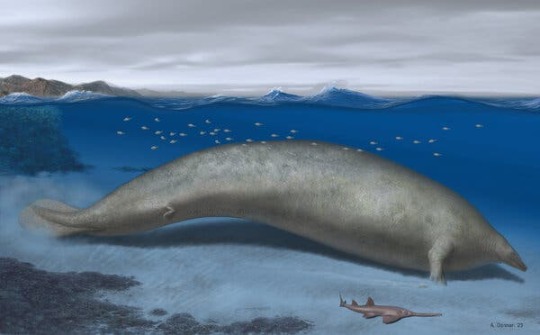
(illustration by Alberto Gennari, 2023)
#SO MANY OTHER WAYS OF BEING A WHALE#PROPELLING ITS SAUSAGE-LIKE BODY WITH A PADDLE-SHAPED TAIL#I WOULD LOVE TO SEE THE SKULL OF THIS GUY#basilosauridae#basilosaurid#perucetus#perucetus colossus#paleoblr
172 notes
·
View notes
Text

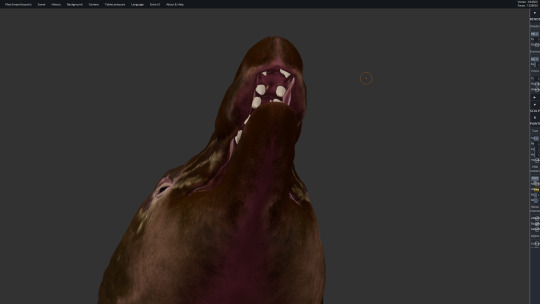

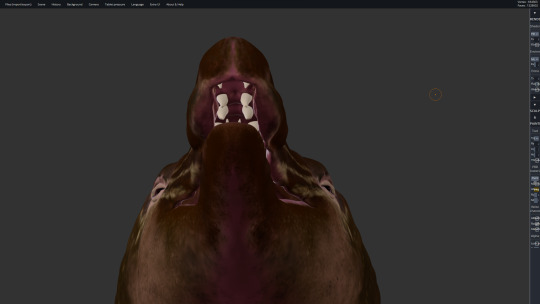
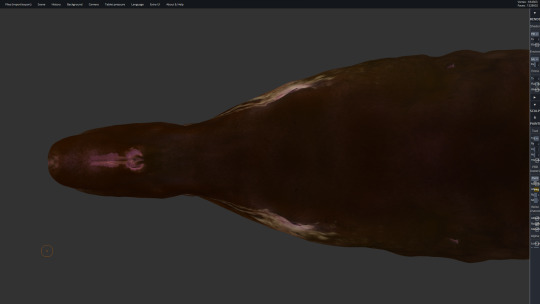
*Another* Archaeocete bust update that I posted to Twitter but forgot about sharing here, this time its my Georgiacetus render, redone this year to improve on the version I did in 2020.
This one also got some additional mass packed on the bones and some new colors applied to it, compared to the original, and I hope someday to make a physical, life-size version of this piece, however long it takes to get to that point.
Like B. cetoides, this ancient whale was also first found in the Southeastern U.S., but in Georgia instead, and its postcranial skeleton is rather disarticulated and incomplete. The earliest fossils of Georgiacetus vogtlensis are about 5 million years older than the first Basilosaurs, with a much more basal body plan: a larger and better developed pelvis, suggesting prominent legs (which would have been the main source of propulsion since it lacked flukes), a shorter torso and tail, and an altogether smaller body size (estimated to between 10 and 20 feet long). With the scarcity of postcranial material for this genus (such as limbs, certain vertebra, all but the tip of the tail, most of the ribs), our estimation of the animal is informed by fossil material from other, better represented Protocetids. Like the later appearing Basilosaurids, however, Georgiacetus's pelvis was not fused to its vertebrae, and their skulls are visually pretty similar.
This mesh was rendered in Sculptfab and SculptGL, with these screenshots being taken in the latter program.
#Georgiacetus vogtlensis#Georgiacetus#Archaeoceti#Protocetidae#Cetacea#North American Prehistory#Paleoart#Digital Sculpture#Sculptfab#SculptGL#Prehistoric Life#Whale Evolution#Christopher Maida Artwork
45 notes
·
View notes
Text
In the span of eight days, we have seen the descriptions of the biggest basilosaurid known (Perucetus colossus) and the smallest (Tutcetus rayanensis)
38 notes
·
View notes
Text
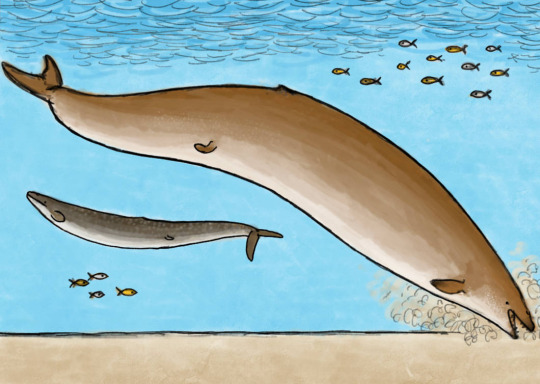
One Whale to Rule Them All: Impression of Perucetus, a giant, possibly mollusk-eating Archaeocete which lived in the Eocene of Peru 39-37 million years ago and is considered a true colossus among early cetaceans. At up to 17-20 meters long and 85-340 tons in weight, Perucetus surpassed Basilosaurus in size as the largest of the basilosaurids, and as possibly one of the largest and heaviest prehistoric sea-creatures ever to have existed.
References:www.nature.com/articles/s41586…
#perucetus#paleontography#paleontology#eocene#cenozoic life#cenozoology#cenozoic#whale#basilosauridae#cetaceans
39 notes
·
View notes